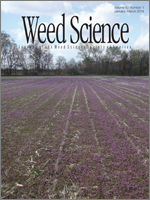Winter annual weeds protect the soil from erosion and retain nutrients during the winter; however, they can also act as a host for crop pests and pathogens and impede planting. Increased knowledge of the reproductive biology and the seed fate of winter annuals would be useful to improve management and crop productivity. The objectives of this research were to determine the recruitment biology of shepherd's-purse, henbit, common chickweed, and field pennycress, including seed production, dispersal, dormancy, and seedling emergence, based on growing degree days (GDD). Henbit was the least prolific of the four weeds studied, producing 800 to 40,000 seeds m−2 at naturally occurring densities; shepherd's-purse was the most prolific, producing 11,000 to 400,000 seeds m−2 with 40 to 230 plants m−2. Fifty percent seed rain occurred for henbit, common chickweed, shepherd's-purse, and field pennycress at 620, 790, 880, and 1300 GDDBase,0C, respectively. Overall, seeds were dormant for all species at the time of dispersal. In 2 of 3 yr, dormancy of later-dispersed common chickweed decreased after 6 mo of storage at natural, fluctuating temperatures in the absence of water. The emergence patterns of the four species followed the Gompertz equation and were indicative of facultative winter annuals. The emergence patterns by rate were similar between henbit and common chickweed and between shepherd's-purse and field pennycress. Seed production, dispersal, dormancy, and seedling emergence were influenced by moisture; therefore, including a precipitation or soil moisture component into a GDD model (such as the use of hydrothermal time) would improve the accuracy of predicting winter annual reproduction, seed fate, and emergence.
Nomenclature: Common chickweed, Stellaria media (L.) Vill. STEME; field pennycress, Thlaspi arvense L. THLAR; henbit, Lamium amplexicaule L. LAMAM; Shepherd's-purse, Capsella bursa-pastoris (L.) Medik. CAPBP.





